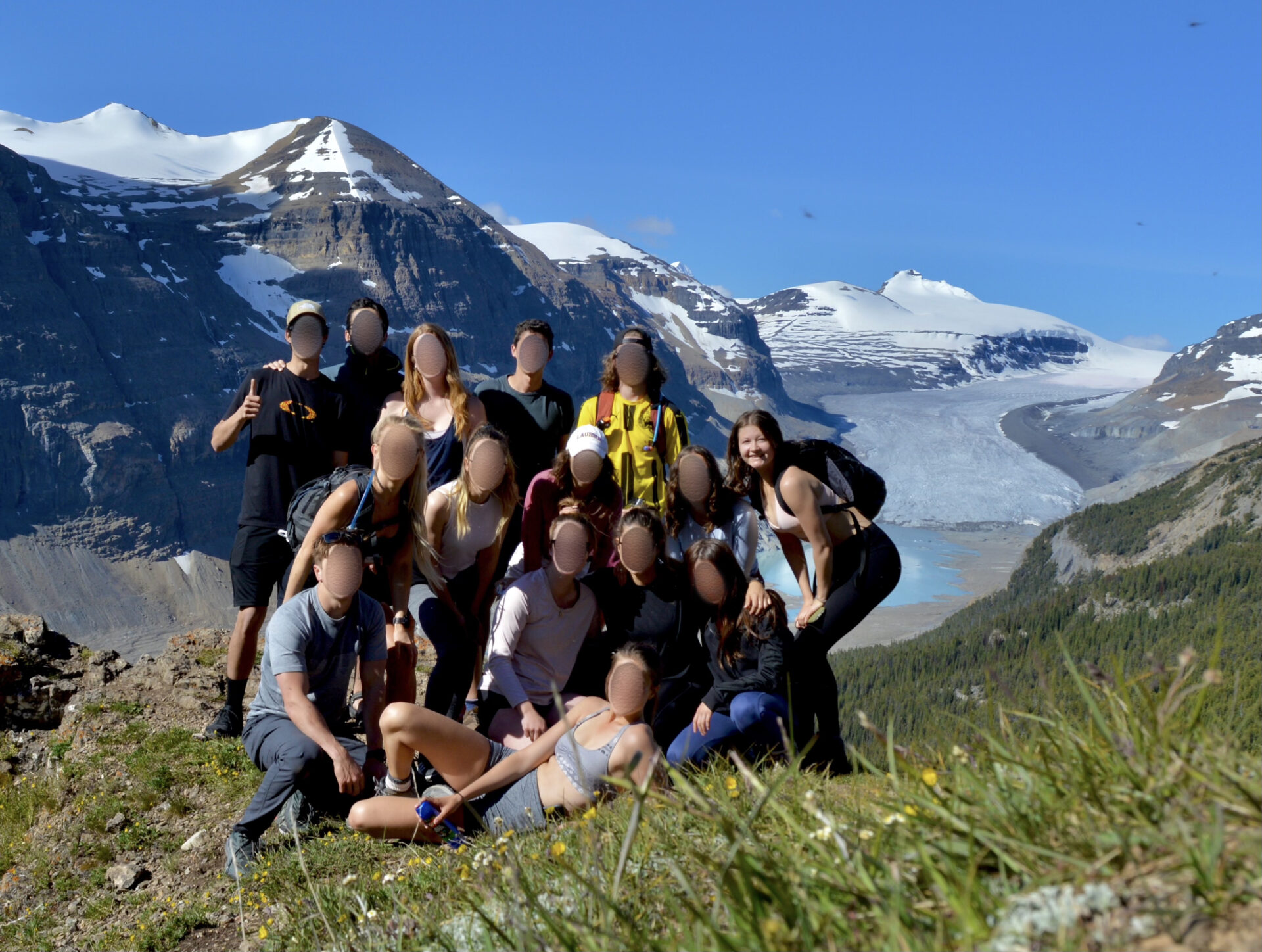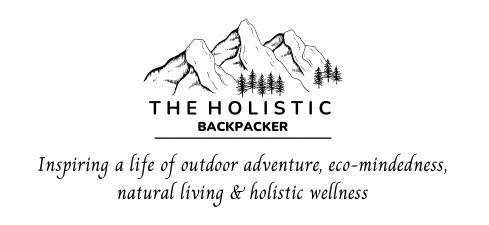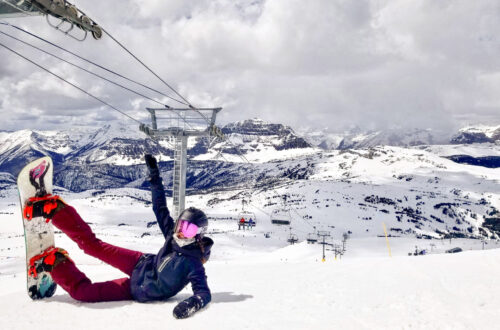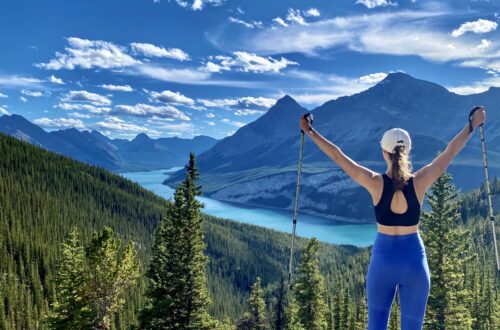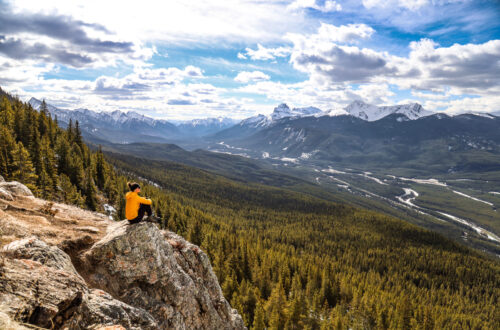
Johnston Canyon Ink Pots Hike Guide + Winter Tips
Johnston Canyon is one of the most – if not the most – popular hike in Banff. The Johnston Canyon trail follows a metal boardwalk between towering canyon walls and passes multiple blue waterfalls before reaching the vibrant Ink Pots.
The Johnston Canyon hike is beautiful in summer, but in winter its waterfalls ice over and the canyon becomes a complete winter wonderland.
In this guide I’ll tell you everything you need to know about the Johnston Canyon Ink Pots hike including hiking stats, parking/bus information, nearby camping opportunities, and winter trail information.
Skip ahead:
- How to get to the Johnston Canyon Ink Pots hike
- Where to stay in Banff
- About the Johnston Canyon Inks Pots trail
- Johnston Canyon Tours
- Hiking the Johnston Canyon Ink Pots trail
- Hiking Johnston Canyon in Winter
- Canadian Rockies hiking & camping tips
- Canadian Rockies gear recommendations
As you read this post, please consider clicking the links throughout. These are affiliate links which means when you book a hotel or purchase a product, I make a small commission at no additional cost to you (full disclosure). These commissions fund The Holistic Backpacker and help me write more blog posts.
Thank you for supporting my work!
Johnston Canyon Ink Pots Hike
Banff Google Map: 600+ Pins
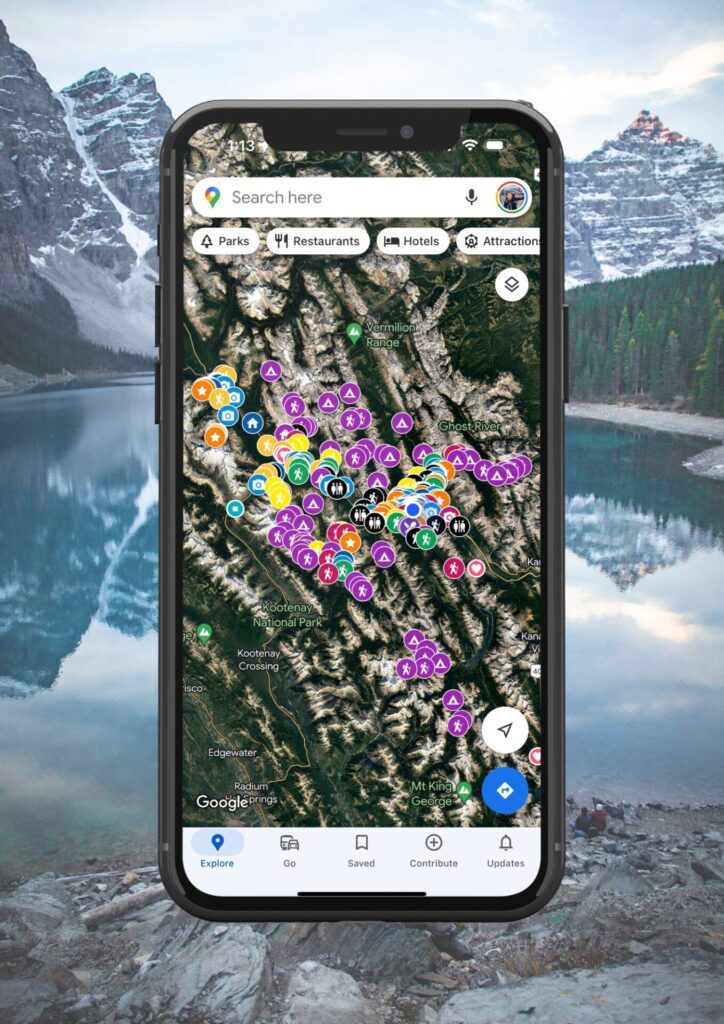
Get my 600+ Banff recommendations saved to your Google Maps app
Outdoors: 100+ hiking trails, backcountry campgrounds, ski resorts, waterfalls & lakes
Planning: lodging, restaurants, public washrooms & transit hubs
Things to do: tours, viewpoints & unique activities
I lived in Banff for years and know all the best spots!
My Featured Banff Blogs
Travel Guides
Banff Activities
Quick Banff Guide
First time visiting Canada? This page outlines all my travel tips for those new to Canada.
When to visit: this post breaks down each month in Banff with average temperatures and corresponding activities.
How to get to Banff: fly into Calgary International Airport. From here, rent a car (what I recommend), RV, or take one of the following shuttles to Banff:
- Budget: On-It runs during the summer months and Pop-a-Ride is a ride-share program. You can use my Poparide link to save $5 on your first trip.
- Professional shuttles: Banff Airporter and Brewster.
- Car rental: having access to a car is the best way to travel to/from/within Banff. This site compares the best local rates.
Best Activities in Banff: here are all my recommendations for the best tours, activities, and unique experiences in Banff & beyond.
Moraine Lake or Lake Louise: read my guide for how to get there with the new road closures. If you want to see Moraine Lake at sunrise, you can book a shuttle here.
Lodging & Camping: Here’s my guide for hotels in Banff (Organized by Category). If you’re visiting during peak summer (mid June to early September), make your lodging reservations FAR in advance. Front country and backcountry camping reservations must be made on the Parks Canada reservation system. The system typically opens in January and it’s recommended you make reservations then.
Reservations: for activities and restaurants should be made well in advance during summer. Get Your Guide and Viator are popular tour booking platforms whereas OpenTable is used for restaurants.
Parks Pass: You’ll need a National Park Pass for your vehicle for each day you’re in Banff. Passes can be purchased at the East Parks Gates, the Visitor Centre, or online. If you’ll be in any of Canada’s National Parks for more than 7 days in a 365 day period, an annual Discovery Pass offers a better rate than purchasing individual day passes.
Roam Transit: once you arrive in Banff, use the local transit service as much as possible to avoid parking issues. There are bus lines within town, plus lines to popular spots like Lake Louise and Johnston Canyon. The bus to Lake Louise should be reserved in advance.
Parking: the best spot to park is the free lot next to the train station. More information about parking in town can be found here and parking fees can be paid here. Bylaw is strict, so ensure you’re following parking rules exactly.
Wildlife Safety: 11 ways to stay safe from wildlife, bear safety, & bear basics.
Johnston Canyon
Ink Pots Banff
Connect via socials:
Sign up for emails to receive a 25% discount on my travel maps.
Taylor ♡
Johnston Canyon Ink Pots
How to get to the Johnston Canyon Trailhead
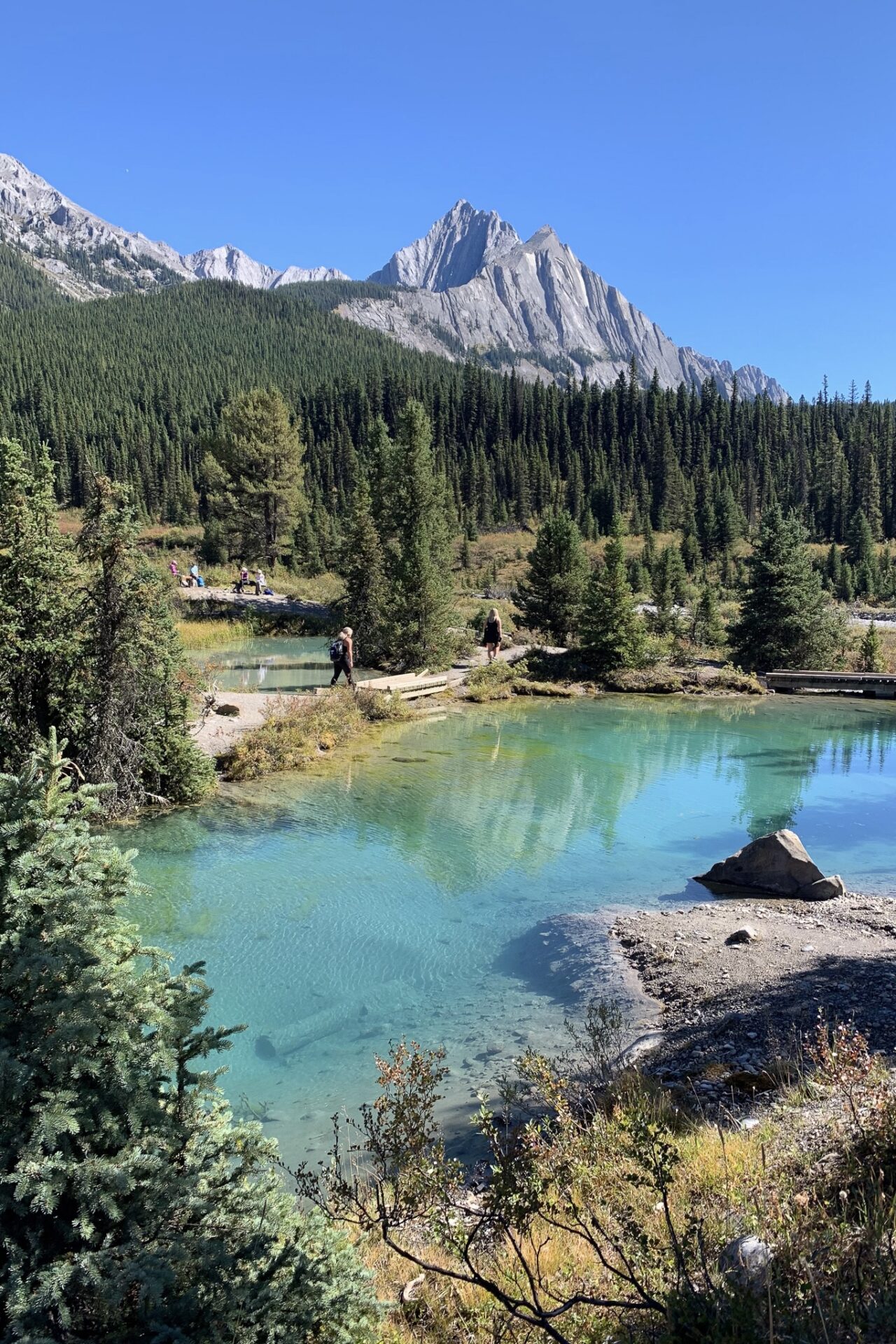
Johnston Canyon is located along the scenic highway 1A in Banff. The drive is approximately 1hr 45mins (180kms) from the Calgary International Airport and 1hr 20 minutes (115kms) from Golden.
If you’re looking to hike Johnston Canyon and the Ink Pots, you can start from one of two trailheads; Johnston Canyon or Moose Meadows – Johnston Canyon being the more popular option. There are two parking lots at the Johnston Canyon trailhead, but they fill up entirely on weekends and on a daily basis during the summer months. Arrive as early as possible to ensure you get a spot.
Looking to rent a car while you’re in Banff? Check out my blog post for Canada’s best budget car + RV rental options.
Moose Meadows on the other hand almost always has space and is a good place to park as a plan B.
Typically visitors need to drive to all the trailheads in Banff, but Johnston Canyon has a direct bus from town. To get to Johnston Canyon by bus, take line 9 with Roam Transit. The bus typically runs mid May to mid October, however the route maintains a schedule on Saturdays and Sundays throughout the entire year. Bus fees are $10 roundtrip and can be paid in exact change upon boarding or via the ‘Token Transit‘ app.
If you’re looking to get an early start or stay within walking distance from Johnston Canyon and the Ink Pots, you can opt to stay at the Johnston Canyon Campground (which is located across the street from the trailhead), at the Johnston Canyon Lodge & Bungalows (next door to the trailhead), or the HI Mountain Wilderness Hostel and Castle Mountain Chalets which are both located a 10 minute drive down the road.
Alternatively, all my Banff lodging recommendations are listed below.
Where to Stay in Banff
From hostels to camping to luxury hotels – Banff has accommodations for everyone. Here are my top recommendations for where to lodge in Banff based on every budget.
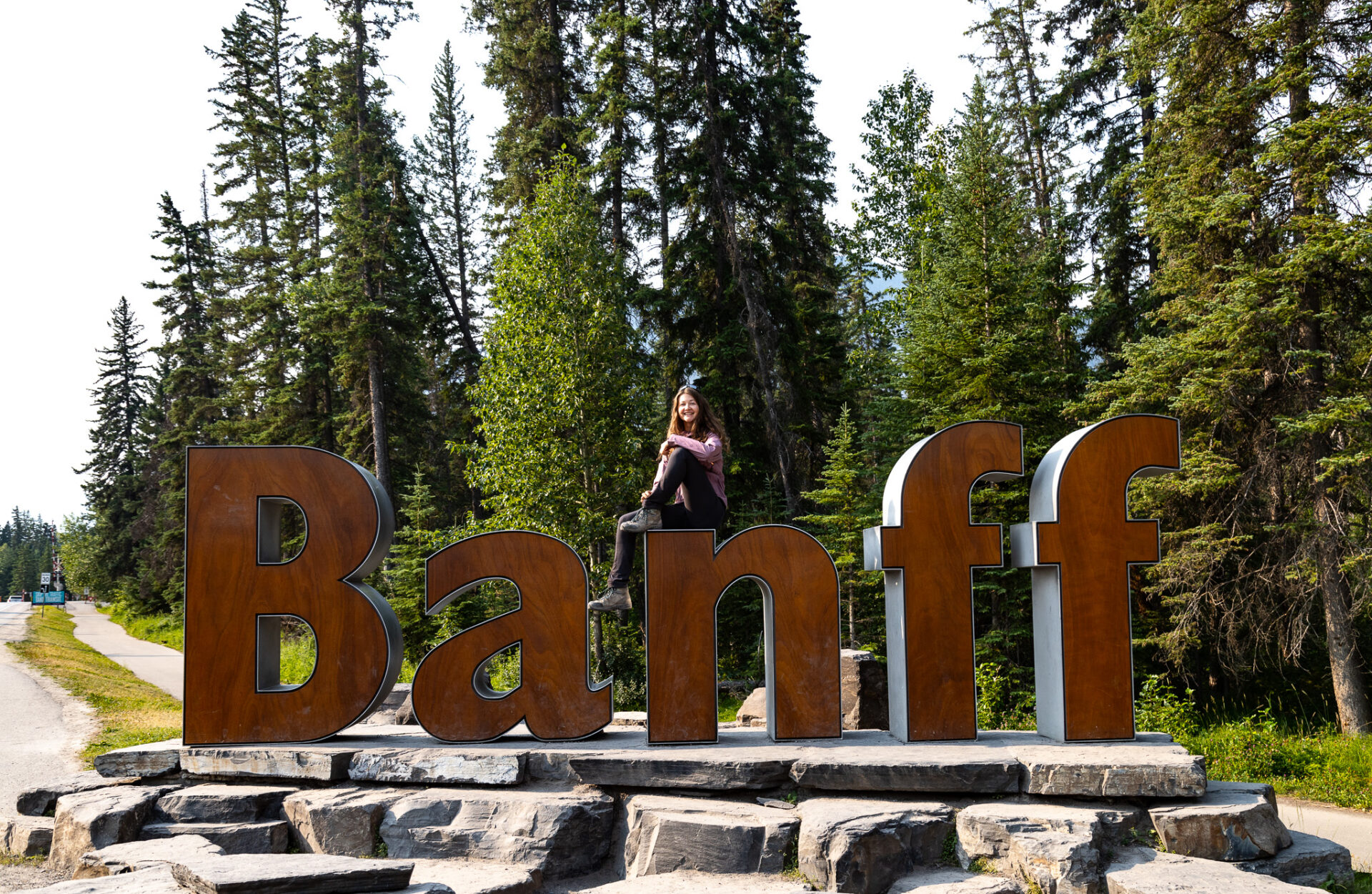
I recommend giving this post a read as I’ve listed every Banff hotel worth staying at and organized them by category.
- Hostels – Samesun Banff (best location + bar/restaurant on-site), Banff International Hostel (second best), and HI Banff.
- Budget hotels – Bow View Lodge and High Country Inn.
- Mid-range stays – Banff Park Lodge, Mount Royal, Elk & Avenue, and the Banff Caribou & spa.
- Luxury stays – Fairmont Banff Springs and the Rimrock Resort.
- Cabin retreats: Johnston Canyon Bungalows, Baker Creek, and Castle Mountain Chalets.
- Camping – reservation information can be found here. Ensure you book campsites far in advance as they’re full during summer.
- For those on ski trips: lodge on-mountain at Sunshine Village, stay near Norquay, and see my Lake Louise suggestions below.
Lodging Options Near Banff
Enjoy the nature and activities of Banff National Park, but lodge away from the busy tourist town centre at any of the following:
- Lake Louise – Fairmont Chateau Lake Louise (luxury), Paradise Lodge & Bungalows (500m from the lake), Lake Louise Inn (value stay), HI Lake Louise (hostel).
- Canmore – Malcolm Hotel (luxury), Stoneridge Mountain Resort (condo suites with fully equipped kitchens), Mountain View Inn (budget), Canmore Downtown Hostel & the Canmore Hostel (party hostel).
- Johnston Canyon – Johnston Canyon Lodge & Bungalows, Castle Mountain Chalets, and HI Castle Mountain Hostel.
- Yoho National Park – Emerald Lake Lodge and Cathedral Mountain Lodge.
- Kootenay National Park – Storm Mountain Lodge & Cabins.
- Kananaskis Country – Mount Engadine Lodge and Kananaskis Mountain Lodge (luxury), Crosswaters Resort (mid-range), and HI Kananaskis Wilderness Hostel (budget).
Top Tours & Excursions in Banff
Banff Gondola – epic views from the top of Sulphur Mountain.
Banff Hop on Hop off – explore the park at your own pace.
Lake Minnewanka Cruise – take a scenic boat ride down the largest lake in Banff.
Moraine Lake sunrise – chartered bus to see alpenglow on Canada’s most beautiful lake.
Norquay via ferrata – epic beginner friendly climbing route across iron bars on Mt Norquay.
Sunshine Meadows Gondola – find wild alpine flowers and hike around pristine alpine lakes.
Click here for a complete list of the Banff tours I recommend:
About the Johnston Canyon Ink Pots Trail
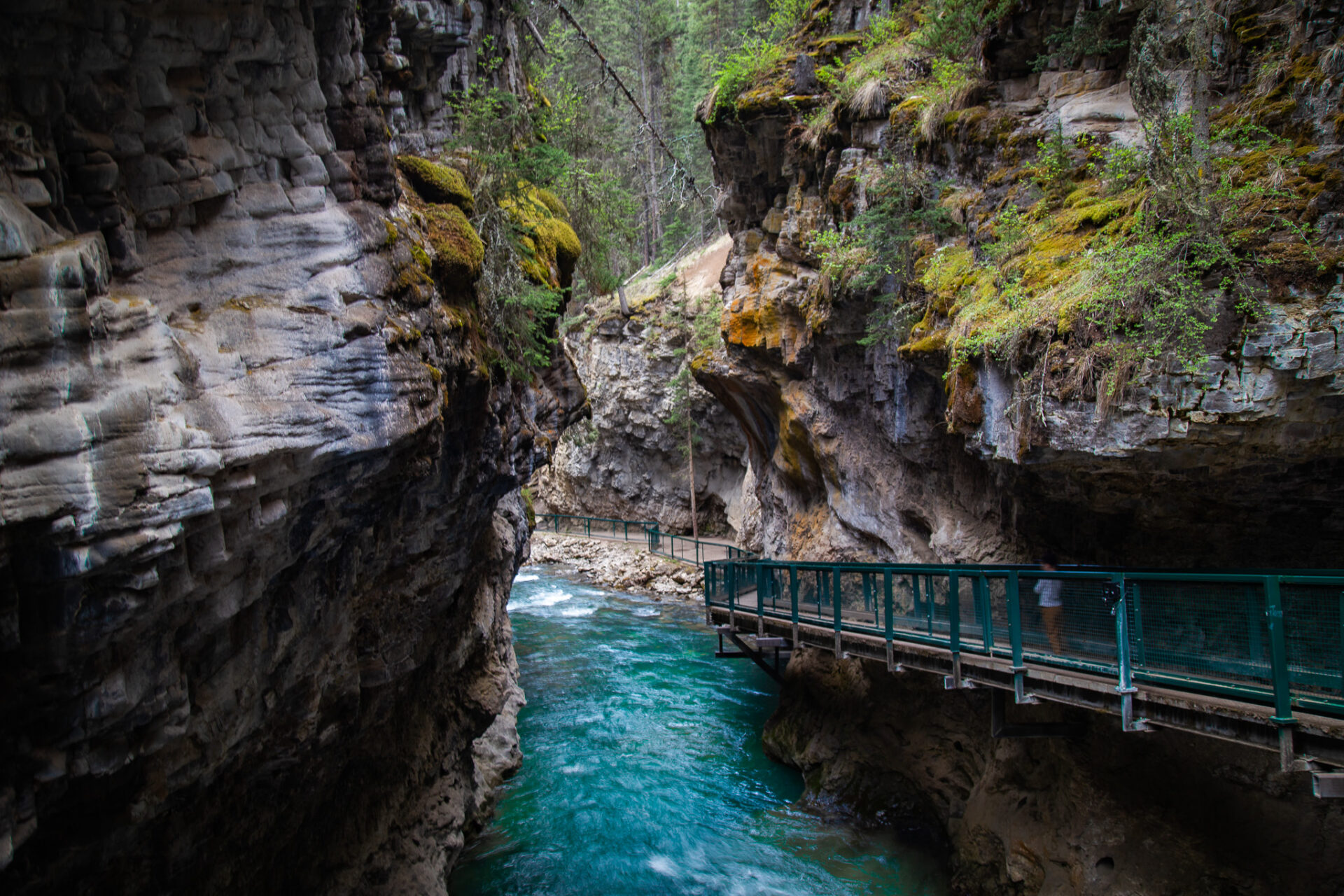
- Distance: 11.7km
- Elevation gain: 608m
- Rated: moderate
- Type of trail: out & back
- Estimated time: 4-4.5hrs (2hrs roundtrip for the Upper Falls only)
The above statistics are if you were to hike all the way to the Ink Pots. If you choose to hike to the Upper Falls only, you can take 6.2kms and 334m of elevation gain off the above.
If you opt to hike the Johnston Canyon Ink Pots trail from Moose Meadows, you can reference this Alltrails map instead. This trail allows you to bypass the busy canyon and go straight to the Ink Pots through an entirely forested route.
Johnston Canyon is a very popular hike in Banff National Park. As a consequence of its popularity, the trail is almost always jam packed – especially if you’re planning to visit during the summer months. If you’re hoping to “beat the crowds,” I’d recommend visiting during shoulder season, winter, or starting very early/late in the day.
The Johnston Canyon portion of the hike follows a metal boardwalk through steep canyon walls where you’ll have the chance to look down over a river of blue water. There are both the Upper Falls and Lower Falls section where you’ll find waterfalls of varying sizes.
Banff Google Map: 600+ Pins

Get my 600+ Banff recommendations saved to your Google Maps app
Outdoors: 100+ hiking trails, backcountry campgrounds, ski resorts, waterfalls & lakes
Planning: lodging, restaurants, public washrooms & transit hubs
Things to do: tours, viewpoints & unique activities
I lived in Banff for years and know all the best spots!
In summer when it’s busy you can expect to wait in line at the Lower Falls for your photo op. This is a great place to practice your patience skills as the atmosphere can get quite hectic and the wait can be lengthy.
Once you pass the Upper Falls the crowd thins drastically and you’ll enter a beautiful forested section for the remainder of the hike until you reach the Ink Pots. The Ink Pots are a series of multicoloured pools which sit in a gorgeous valley – so gorgeous in fact that it’s become my favourite section of the entire Johnston Canyon Ink Pots hike.
You can hike the Johnston Canyon trail to the Ink Pots year round. I talk about hiking Johnston Canyon in winter later in this blog post.
Johnston Canyon Tours
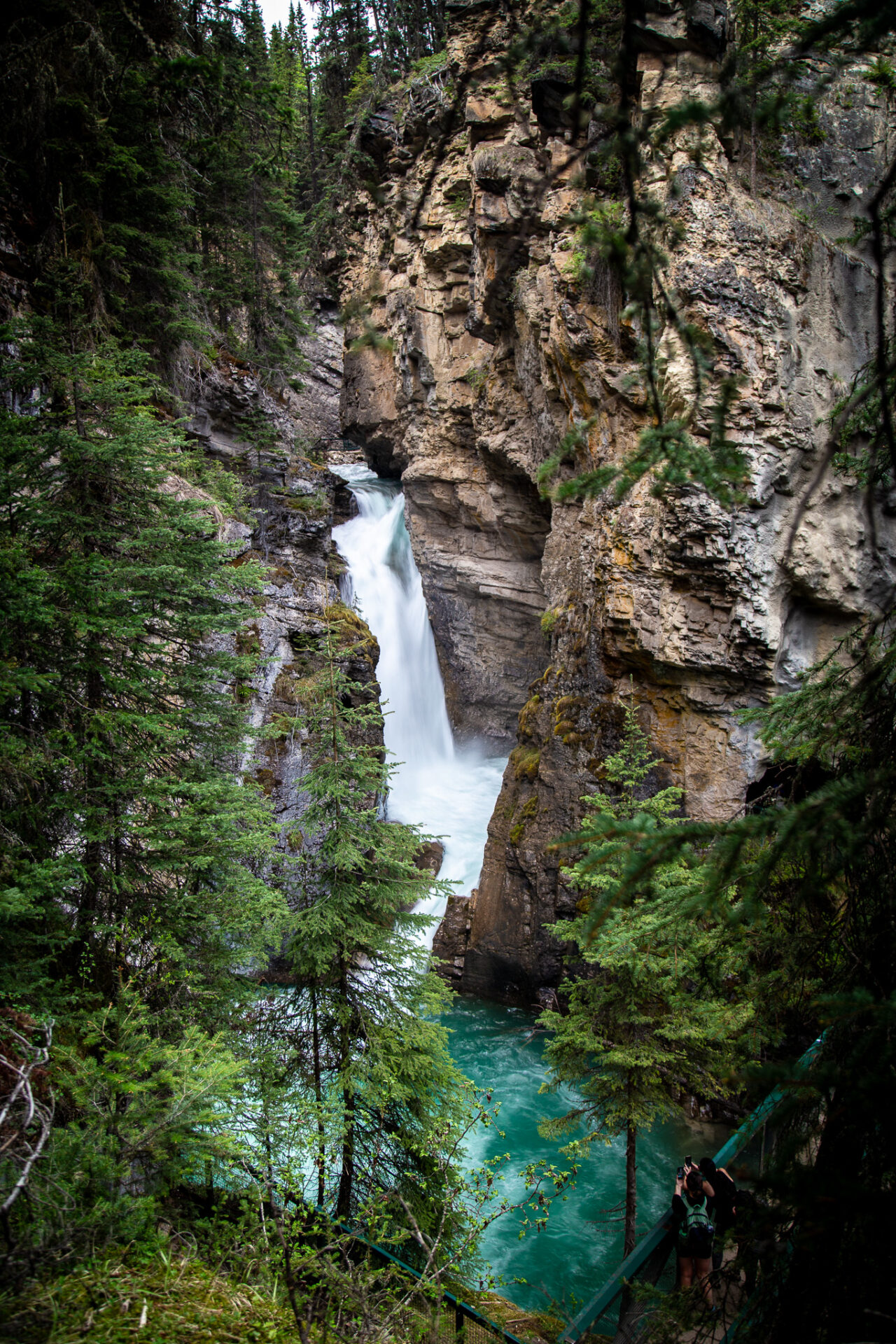
You can 100% hike Johnston Canyon without a tour guide, however I’ve linked a few trustworthy Johnston Canyon tours below. Johnston Canyon tours are popular for a few reasons:
- A knowledgeable guide provides transportation and accompanies you along the hike. They share geographic context and stories of the canyon
- In the winter you’ll receive spikes for the canyon + your guide makes tasty hot chocolate at the end
- Outside of summer the bus schedule is limited. Travellers without a car can visit Johnston Canyon at any time with a guided tour
- New hikers may feel more comfortable hitting the trail with a certified guide
- To meet other travellers
The Best Johnston Canyon Tours:
- Day trip to Johnston Canyon from Calgary
- E-bike the scenic 1A and hike Johnston Canyon
- Johnston Canyon Icewalk (only available in winter)
- Johnston Canyon Evening Icewalk (only available in winter)
- Johnston Canyon + Morant’s Curve + Marble Canyon in Kootenay (from Calgary, Canmore, or Banff)
I also love the idea of this self guided audio tour. It spans Johnston Canyon in addition to 30 other locations in Banff, Jasper, and Yoho National Park.
Hiking the Johnston Canyon Ink Pots Trail
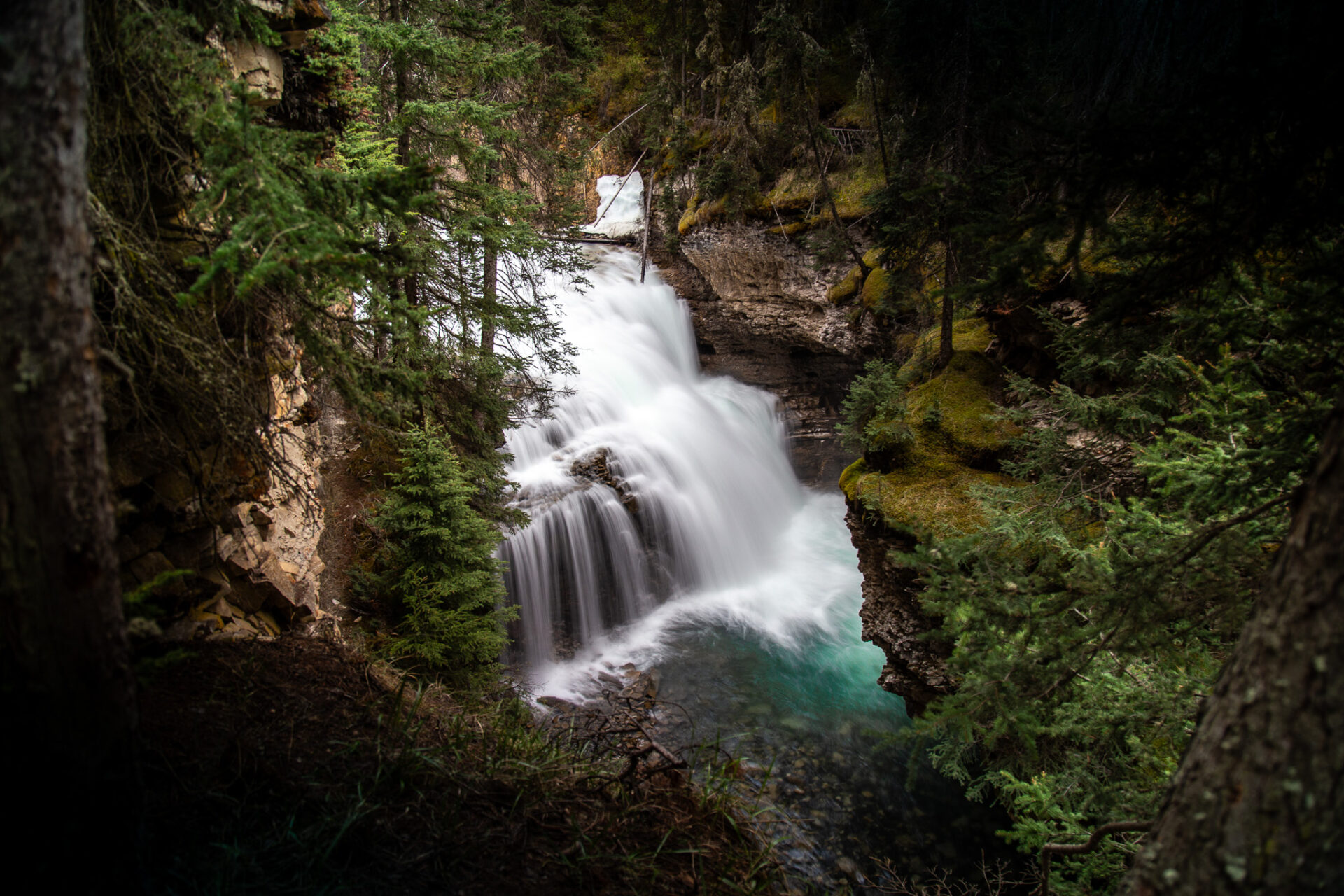
From the Johnston Canyon trailhead you’ll begin to climb gentle elevation right away. Soon after the trailhead, the metal boardwalk starts which gives you a front row seat to the vibrant blue water flowing beneath your feet.
After meandering through the towering canyon walls for a while, the first notable point of interest you’ll come across is the Lower Falls. To see the falls you’ll cross the bridge and enter a small cave. This is where you’ll find the most significant “traffic jam” on the trail. If you want your photo here, you’ll have to wait in line.
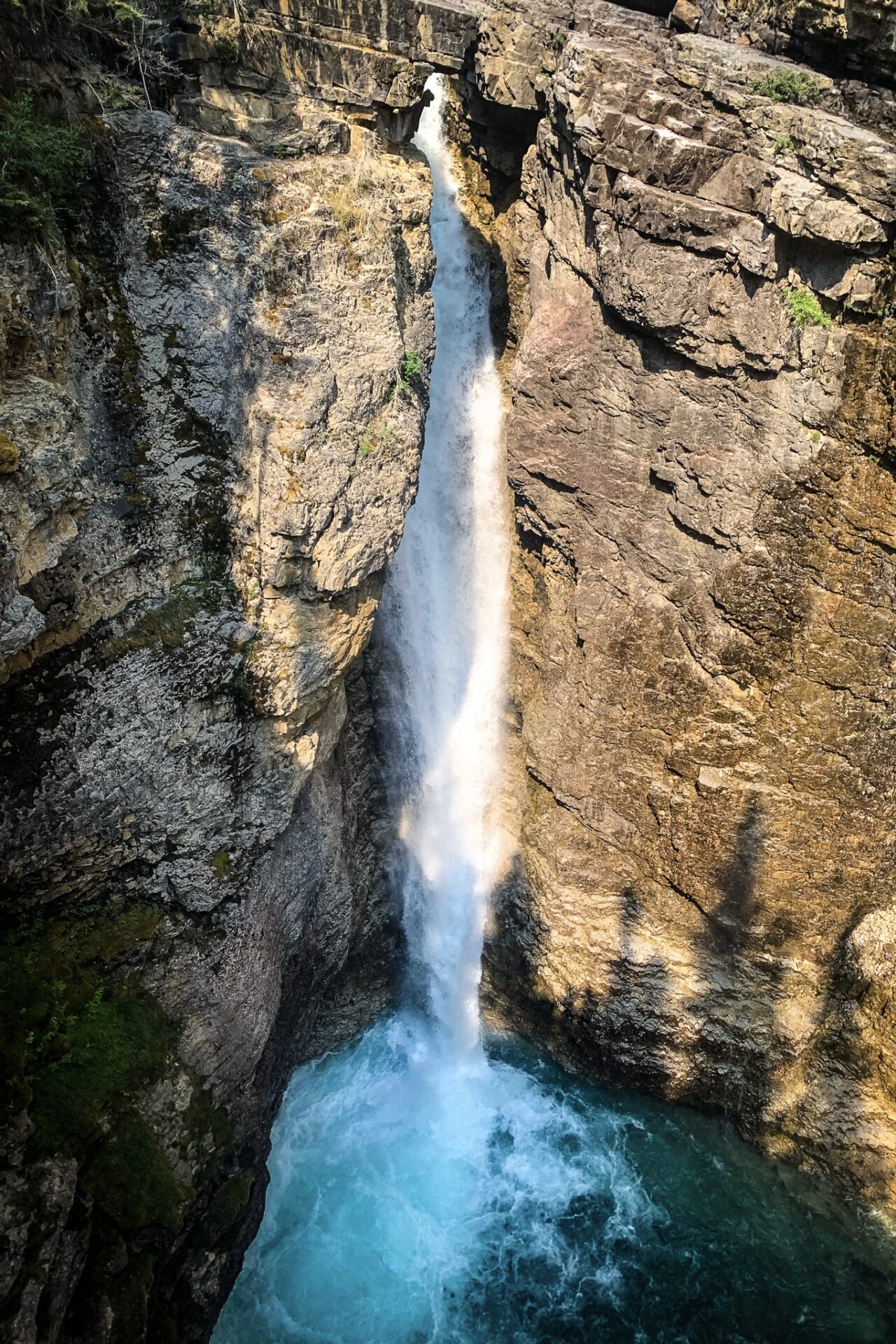
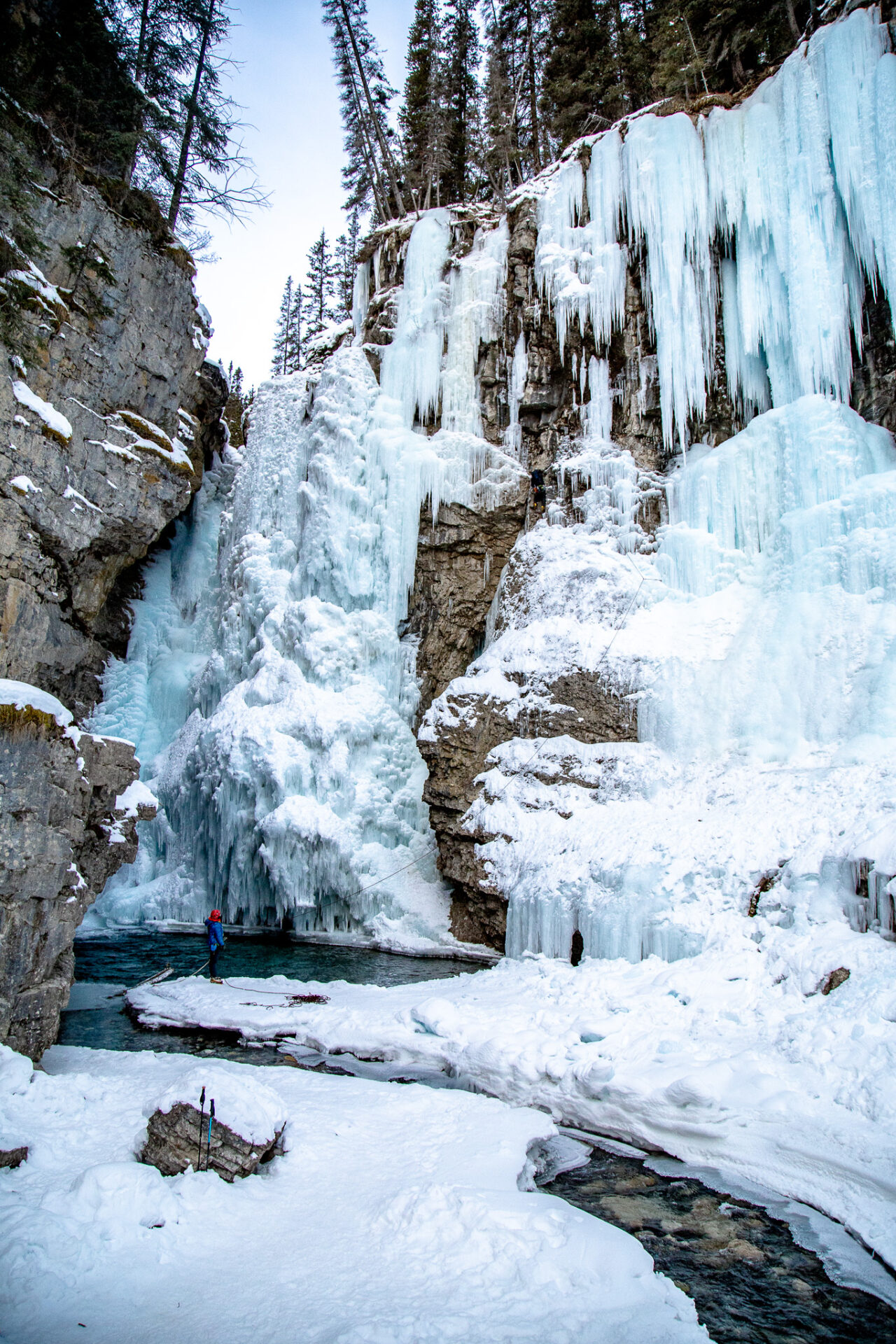
After the Lower Falls you’ll continue along the trail, passing a few smaller waterfalls along the way, until you reach the Upper Falls. The Upper Falls is the tallest waterfall on the Johnston Canyon trail and where ice climbers love to spend their time during the winter months.
Upper Falls to the Ink Pots
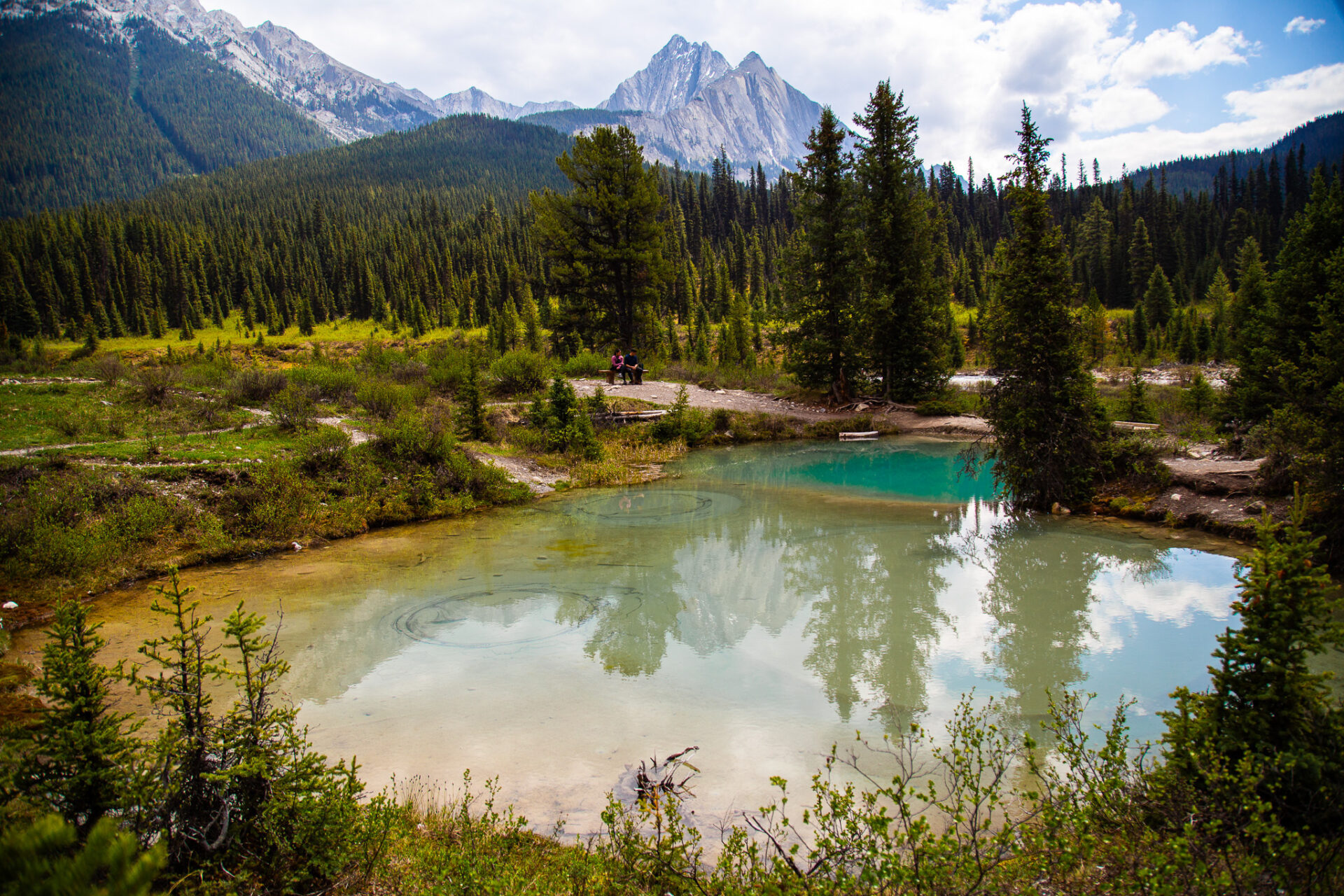
After the Upper Falls hikers have the chance to continue on to the Ink Pots which adds an extra 6.2kms and 334m of elevation to the hike. The views at the Ink Pots make this extra hiking distance well worth the effort.
The entire trail to the Ink Pots from here is mainly forested with minimal views along the way. You’ll gain continuous elevation throughout this section of the hike, but it’s nothing overly strenuous.
Once you arrive at the Ink Pots you’ll find 5 blue/green pools varying in colour due to mineral deposits. The Inkpots are spring fed and maintain an annual temperature of 4 degrees celsius even in the winter which means they typically don’t freeze. The only time you’ll find they partially freeze over is during the January cold snap when temps hit -40.
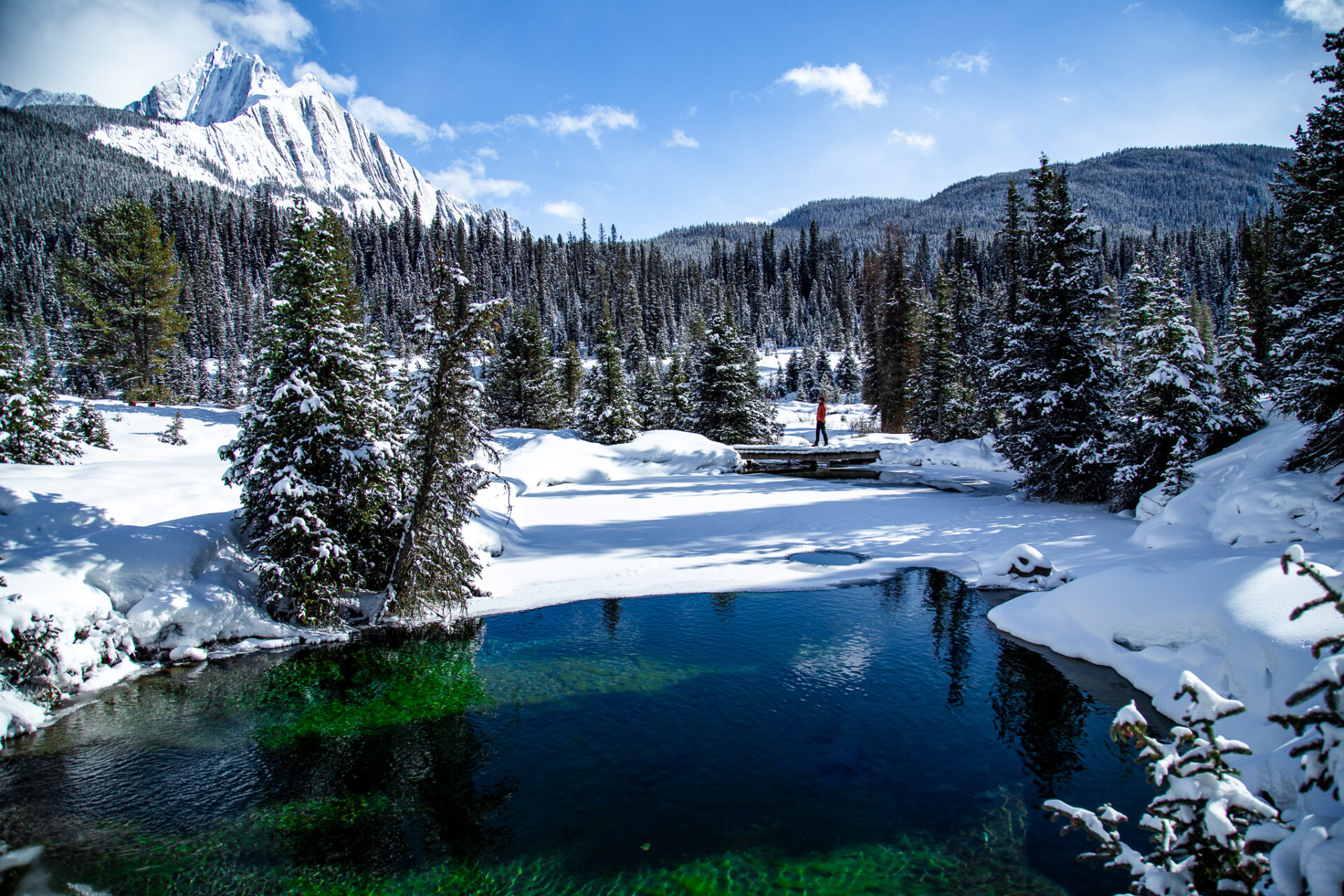
DO look for the bubbles at the bottom of the Ink Pots where the water fills. DON’T swim in the Ink Pots – this is not allowed as the area is extremely fragile. DO enjoy the valley the Ink Pots sit in. The surrounding mountains and vegetation are absolutely lovely.
The Johnston Canyon Creek is nearby which is a nice place to dip your feet into icy cold water on a warm day. From the Ink Pots, hikers can continue along the Sawback Trail which is a multi night backcountry trip that extends all the way to Lake Louise.
Hiking Johnston Canyon in Winter
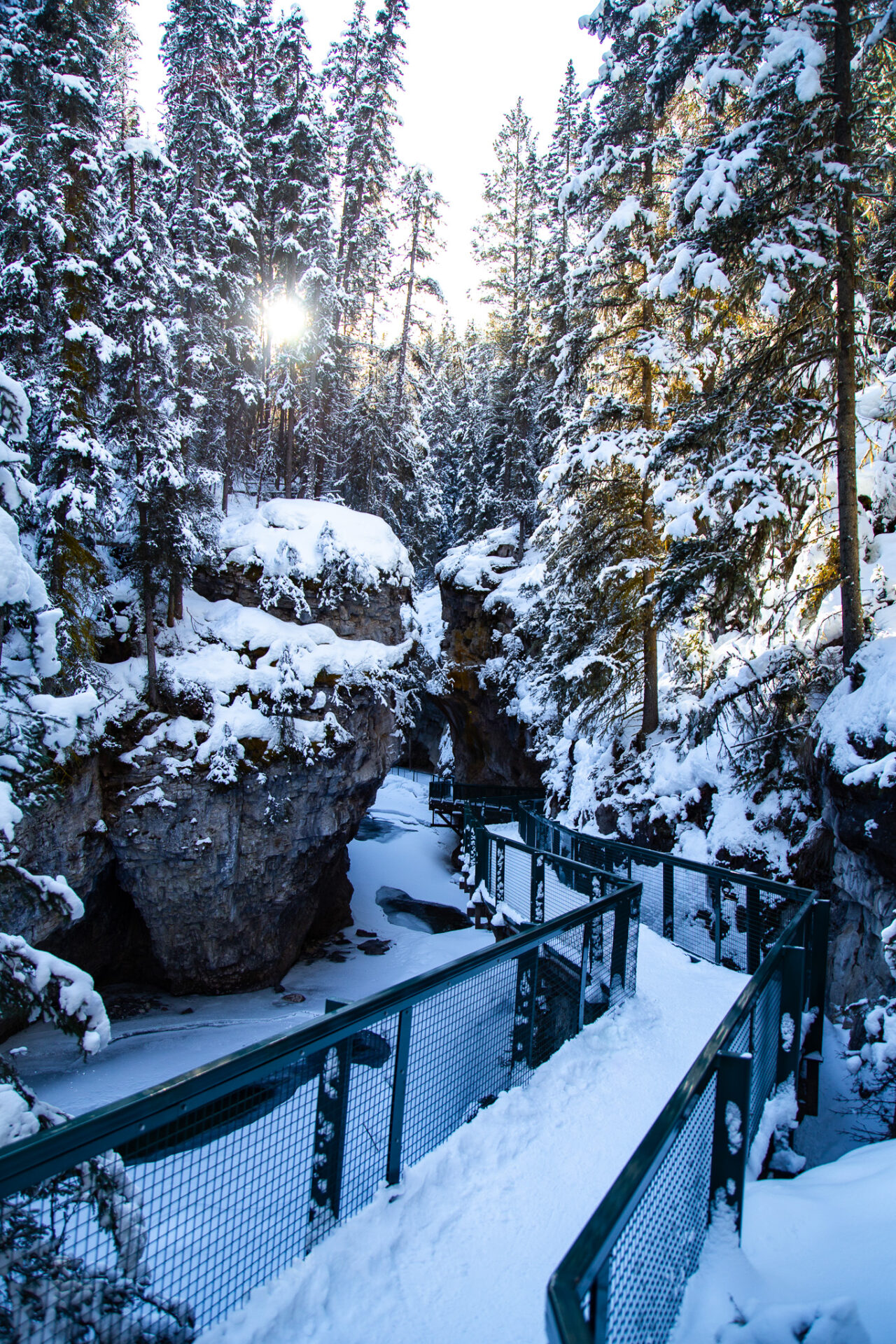
The Johnston Canyon Ink Pots hike is a great trail year round, however in the winter it transforms into a winter wonderland. You’ll find giant frozen waterfalls, ice climbers, and the bright blue Ink Pots that remain unfrozen throughout the entire winter season.
The trail does not cross avalanche terrain which makes this a safe winter venture. It’s recommended hikers always have spikes on-hand as the trail through the canyon can get extremely icy. I’ve got my winter spike recommendations listed above in this blog post along with some of my other favourite winter hiking gear + unique ways to stay warm.
Hikers typically do not need snowshoes to venture to the Ink Pots as the trail is always packed down. The exception to this is if you were to hike to the Ink Pots early in the day after a large snowfall.
Banff Google Map: 600+ Pins

Get my 600+ Banff recommendations saved to your Google Maps app
Outdoors: 100+ hiking trails, backcountry campgrounds, ski resorts, waterfalls & lakes
Planning: lodging, restaurants, public washrooms & transit hubs
Things to do: tours, viewpoints & unique activities
I lived in Banff for years and know all the best spots!
The Johnston Canyon hike is good for dogs
Canadian Rockies Hiking Tips
Guides for hikes in: Banff | Jasper | Kananaskis | Kootenay | Waterton | Yoho
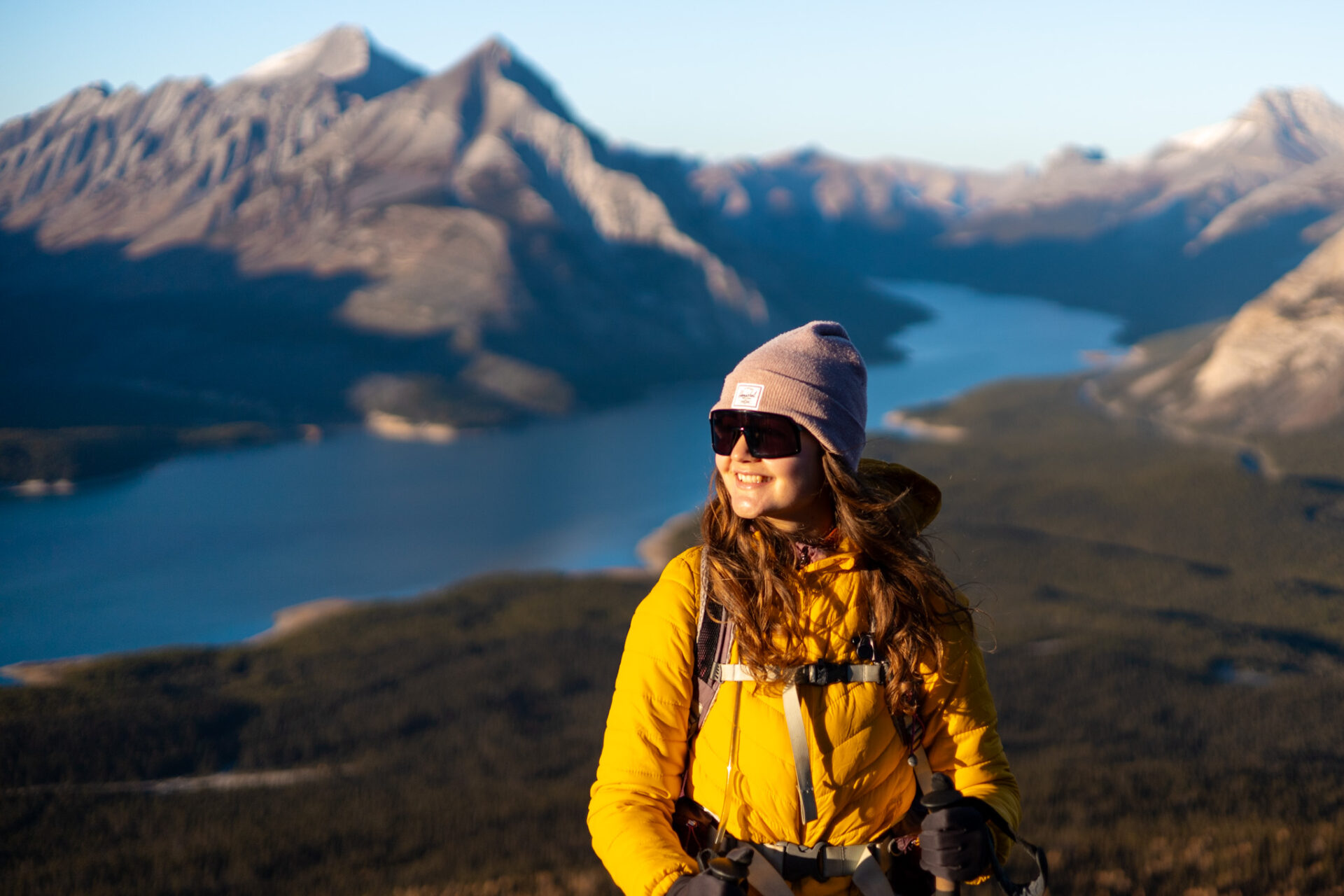
Approach: take a conservative approach if you’re new to hiking and ensure you have lots of daylight. Trails here are steep, long, and can have challenging terrain.
Best Time of Year: July to early September is the most reliable for weather and minimal snow. This post outlines each month in Banff.
- Hiking in winter? Stick to easy, well-trafficked trails unless you’re knowledgeable about avalanche terrain. I always check the avalanche bulletin and use both Caltopo and Google Maps satellite view to survey terrain before hiking.
Pets: leashed dogs are allowed on all trails in the Rockies unless otherwise stated.
Safety: tell someone where you’re going and when you plan to return. I always carry the Garmin InReach Mini for additional safety as there’s minimal cell service in the Rockies.
Wildlife: carry bear spray and know how to use it. Here are bear safety tips from Parks Canada.
Maps: I purchase the Alltrails+ membership and download my maps before hiking so I always know where I am.
Helpful Canadian Rockies Hiking Posts:
More of my detailed hiking tips can be found here
Canadian Rockies Camping Tips
Plan to go camping in Banff and the Canadian Rockies? Here are some useful things to know.
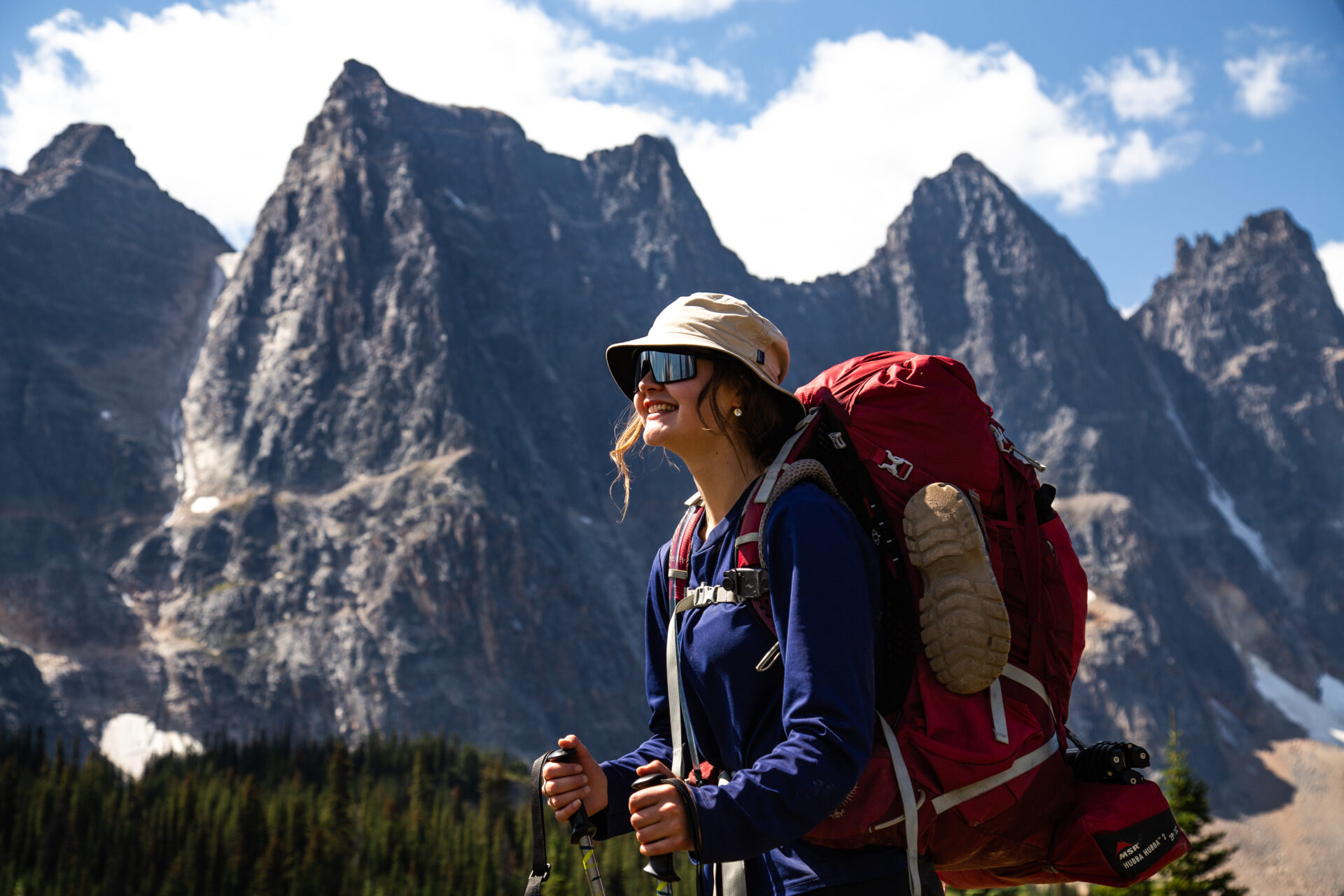
Unless you’re on some form of public land – random camping and free car camping is not permitted in the Canadian Rockies. If you do plan to “free” camp in the designated areas, you must purchase the Public Lands Camping Pass.
Camping Reservations: reservation day (when bookings go live) usually occurs in January. Most summer camping reservations must be made then as sites fill up instantly.
- National park camping reservations can be made here and Kananaskis reservations can be made here: backcountry | front country.
- Can’t get a reservation? Sign up for cancellation notifications via Schnerp. I use this resource frequently and have found cancellations at the most popular spots in the Rockies like Lake O’Hara.
When to Camp: most campgrounds close for the winter, however a few remain open year round. July-August is best for backcountry camping. Keep in mind, temperatures are typically very cold at night even during peak summer.
Hut Camping: the Alpine Club of Canada has established alpine huts scattered around the Rockies and beyond. These huts must be booked in advance and cater to backcountry skiers, hikers, and climbers.
Packing advice and my personal gear recommendations can be found in my Backcountry Gear Guide.
Johnston Canyon Ink Pots Winter Hike
Recommended Hiking Gear for the Rockies
Below are my personal recommendations and favourite products for Canadian Rockies specific hiking gear.
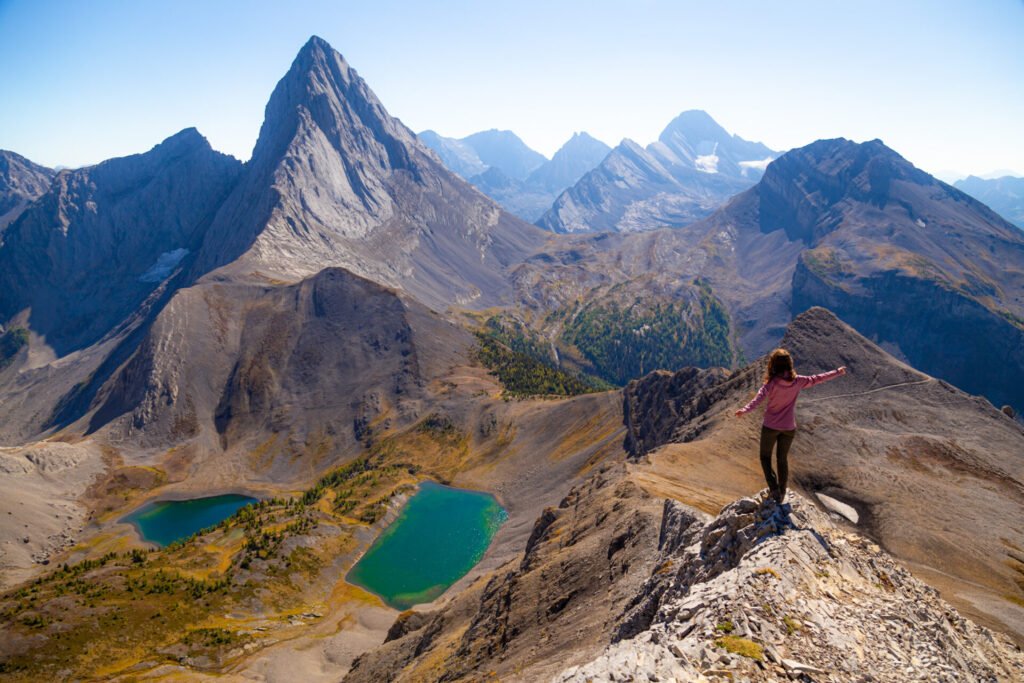
Backpack: I use the Osprey Sirrus 24L (men’s edition) for quick day hikes and the Osprey Sirrus 36L (men’s edition) for longer hikes requiring more gear.
Hydration: I use the 3L Hydrapak to carry water and always have aquatabs on-hand if I need to filter water.
Footwear: I currently use the Scarpa Kailesh (men’s version) and full cushion crew Smartwool socks.
Safety: I always carry the Garmin Inreach Mini 2 as my satellite device.
Here are my detailed posts for Canadian Rockies hiking gear
Rockies Hiking Gear: Winter
If you’re planning to hike the Rockies in winter, you’ll need to add a few more items to your gear arsenal.
The items below are what I use.

Spikes: I love Hillsound’s trail crampon which provides killer traction and long-lasting durability.
Snowshoes: I use TSL’s sustainable Symbioz Hyperflex snowshoe, however any snowshoe from TSL is top of the line. This one is their midrange model which offers similar features at a light weight and better price point.
Gaiters: this is my top pick for gaiters which are great for keeping water and snow out of your boots. If you’re on a budget, these ones are a little more cost effective and have plenty of great reviews.
Warmth: I use Aurora Heat’s reusable hand + ultra foot warmers for both hiking and skiing. They’re made of beaver pelt by Indigenous women in Canada’s Yukon.
Softshell Pants: these are my favourite pants (men’s sizing) for cold weather hiking. They’re water resistant, wind resistant, and warm. If you’re reading from the USA, these REI pants are equivalent: women’s sizing | men’s sizing.
is the Johnston Canyon hike hard
Banff Google Map: 600+ Pins

Get my 600+ Banff recommendations saved to your Google Maps app
Outdoors: 100+ hiking trails, backcountry campgrounds, ski resorts, waterfalls & lakes
Planning: lodging, restaurants, public washrooms & transit hubs
Things to do: tours, viewpoints & unique activities
I lived in Banff for years and know all the best spots!
can you hike to the ink pots in the winter
Happy adventuring!
Taylor ♡
Like This Post?
Share with friends or save it for later!
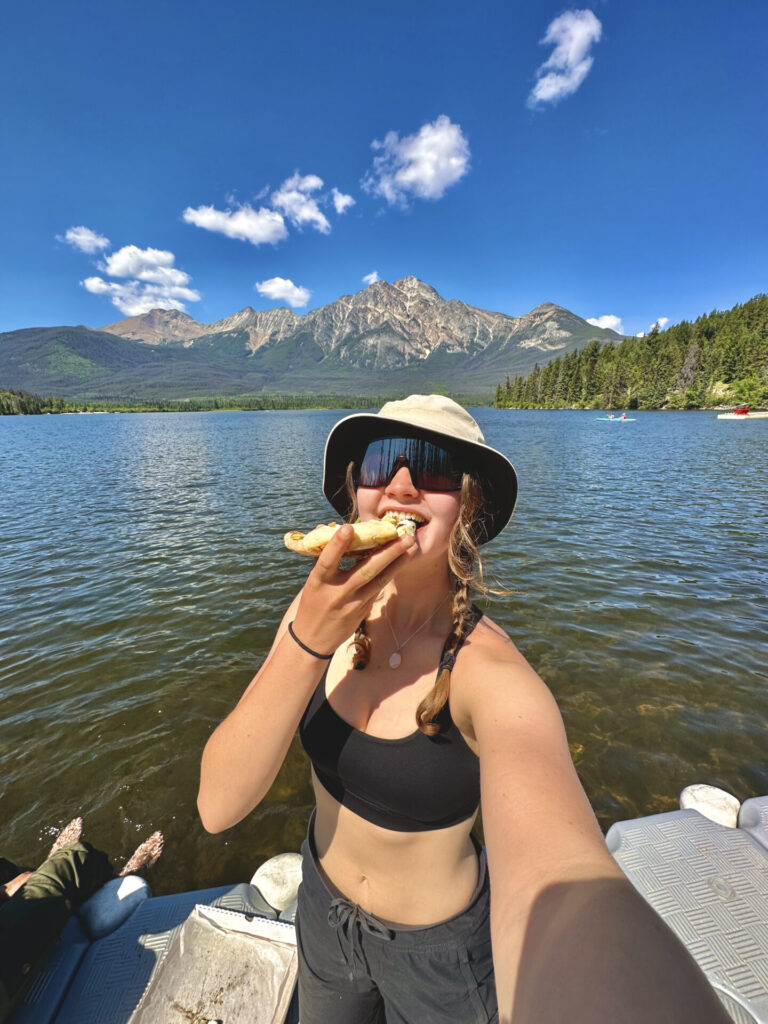
About the Author
HI, I’m Taylor – the voice behind The Holistic Backpacker.
After moving to Banff National Park in 2020 I became an outdoor adventure enthusiast and vowed to never stop exploring.
I now spend my days travelling the world, climbing mountains, and spending nights under the stars in the Canadian Rockies backcountry.
I created The Holistic Backpacker so I could share my adventures and help connect people like you with the same amazing experiences.
